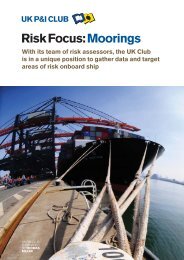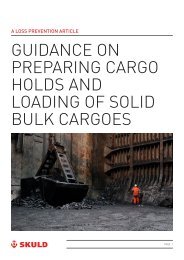You also want an ePaper? Increase the reach of your titles
YUMPU automatically turns print PDFs into web optimized ePapers that Google loves.
<strong>ECSA</strong><br />
<strong>The</strong> <strong>Tramp</strong> <strong>Shipping</strong> <strong><strong>Mar</strong>ket</strong><br />
Executive Summary<br />
MAIN CHARACTERISTICS OF THE TRAMP MARKET<br />
1. Globally competitive markets<br />
2. Close to perfect competition model<br />
3. Different sub-market segments in response to customer needs<br />
4. Competition between sub-market segments for cargo<br />
5. Volatile and unpredictable demand<br />
6. Many small entrepreneurial shipping companies<br />
7. Global ship trading patterns including “cross trades”<br />
8. Ease of entry and exit<br />
9. Very cost effective<br />
Background<br />
1. This report is intended to provide a briefing on the organization and competitive<br />
economic structure of the tramp shipping industry.<br />
2. <strong>The</strong> analysis in this report utilizes the Clarkson Research fleet database of selfpropelled<br />
sea-going Merchant Vessels in excess of 100 Gross Tonnage. This<br />
includes vessels deployed in the bulk, specialized and liner shipping sectors, as<br />
well as non-cargo vessels such as cruise and passenger vessels. <strong>The</strong> fleet excludes<br />
non-propelled vessels, fishing and military vessels, yachts and fixed or mobile<br />
platforms and barges primarily used in the offshore energy sector.<br />
<strong>The</strong> nature of the world shipping business<br />
3. <strong>The</strong> international shipping industry transported 10.5 billion tonnes of cargo in<br />
2014 up from 7.3 billion tonnes in 2004 (Table A1.4), with a fleet of 53,101 cargo<br />
carrying vessels out of a total of 89,636 deep sea ships (see Table 3 below). In<br />
2014 it is estimated that around 85%% of international trade in terms of tonnage<br />
was transported by sea. This is equivalent to 1.5 tonnes per capita, compared to<br />
1.1 tonnes per capita in 2004. With the exception of the cruise and ferry business,<br />
shipping companies mainly serve industrial customers not consumers (paragraph<br />
2.1, p9).<br />
4. Merchant <strong>Shipping</strong> is an international service. <strong>The</strong> ships, which are the primary<br />
business unit, are owned by 22,527 companies with an average of 4 ships each<br />
(see table above); registered under 191 different flags; and subject to international<br />
and port state regulations. <strong>The</strong> business is conducted in international market<br />
places using the US dollar as currency with has no tariffs or other impediments to<br />
free trade.<br />
Clarkson Research Services Limited 3 <strong>Mar</strong>ch <strong>2015</strong>




